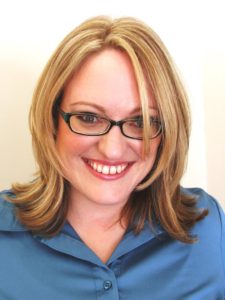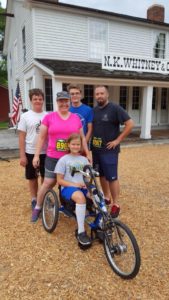The latest interviewee in my How They Do It series is genealogy educator Sunny Morton. I’m familiar with Sunny’s work with Lisa Louise Cooke (who was the subject of my January How They Do It Interview) and Family Tree Magazine. She leads the Genealogy Gems book club and is the author of Genealogy Giants: Comparing the 4 Major Websites. I haven’t yet met Sunny, but based on what I read in this interview, I really look forward to meeting her! Her love for her genealogy and her family shines through.
 How They Do It: Sunny Morton
How They Do It: Sunny Morton
How long have you been doing genealogy?
I’ve participated in personal and family history for just about my entire life. I began keeping a diary at around age 8. As a young teen, I created my first travel scrapbook: a magnetic album packed with notes, receipts, ticket stubs, postcards and even pine needles from a cross-country trip with my family. I kept every letter I ever received, filed alphabetically by the person’s first name, until my early 20s. I still have a couple of binders filled with printouts of the first several hundred personal emails I sent and received, before I realized these were something you could (and should) archive electronically. As an adult, I have compiled more than 40 scrapbooks filled with memories from my own life and those of my relatives.
When I was young, my parents took me along on genealogy road trips. I remember finding gravestones in cemeteries and paging through enormous bound volumes of original newspapers. My grandmother loved to organize photos and negatives and I became her eager assistant. As a young adult, I digitized several years’ worth of family slides and tattered old photo albums. About 15 years ago, I began researching my husband’s family history, since he knew very little about it.
What’s your favorite thing about being a genealogist?
Knowing stories about what came before me. I feel more confident about who I am and why I am that way. I believe that learning about my ancestors has made me less judgmental of my own parents and grandparents and strengthened my relationships with them. I’m a more compassionate human being and a more informed citizen when it comes to having a historical perspective on topics such as civil rights and immigration.
What’s your biggest challenge when it comes to organizing your genealogy?
The transition from paper to paperless. I mentioned that I kept hundreds of letters and emails: what do I do with those? What about those archival scrapbooks, in which I’ve invested thousands of dollars and which are just barely too large to put on my scanner? I know there are ways to digitize these things for safe-keeping and so I can share them with all 3 children. But “editing” which items to scan and doing it would take hundreds of hours that I currently prefer to spend making memories with my children.
The other challenge is organizing tree data. I research across all of the major genealogy websites. I keep “working trees” on all those sites because then I can search and receive hints from each ancestor’s profile. But it’s best to have a master family tree where all the data and record image copies gets compiled. I keep a master, private tree in RootsMagic software. I also participate in the FamilySearch global tree so my research gets shared more widely. Though there can be complications when others dispute details on this open-forum tree, I love the collaborative contributions of many people’s documents, stories and pictures to our common ancestral profiles.
What is your favorite technology tool for genealogy?
My smartphone. It’s always with me, and I can use it in so many ways. I can access my tree data through apps for my software, FamilySearch and Ancestry.com. When I’m the road, I can take pictures of documents, microfilmed records (right from the reader!), other people’s old pictures, family artifacts and gravestones. I can even record oral history interviews, either in audio or video format.
If you were starting out new as a genealogist what would you do differently?
I inherited a lot of genealogy research from others, so for a long time, I ignored recent generations on my own tree. I considered this research “already done” and therefore kind of boring. If I were starting over, I’d spend a lot more time getting to know my grandparents’ generation.
Do you keep a research log? If so, what format?
I keep informal research logs in Word documents. Each ancestor has a document with running commentary about my discoveries and next steps for my research.
How do you keep track of clues or ideas for further research?
I keep them in my research logs for each individual. Toward the end of the document, in the “Next steps” section, I keep notes on intriguing questions to research or resources I’d like to explore sometime.
How do you go about sharing your personal research with cousins or other interested parties?
Most of my sharing happens in the form of telling stories: mostly to my children, but also to my husband, parents or other relatives who may be interested. Telling a story helps me learn which parts are most interesting to which audiences. Sometimes, I take a next step by framing a photo, creating a display or sharing a quick post on Facebook. I do participate in the FamilySearch global tree, which is an easy and organized way to reach potentially thousands of fellow descendants. Although I have written longer articles for genealogy newsletters and historical journals, most of my longer writing projects will have to wait until I’ve finished raising my three children. (That’s Sunny in the photo at left, making memories by participating as a family in a 5k race in July 2018.)
What’s the most important thing you do to prepare for a research trip?
I like to do three things: review what I already know, see what else I can learn online before I go, and locate unique offline sources that may only be discovered while on that trip. This makes my research efforts on the road more productive. A few phone calls to local archives and libraries ahead of time can help me plan my time most effectively, identify must-consult sources and connect with local experts (and perhaps even descendants). I can set priorities about the most important things to accomplish while I’m there and systematically go down my list.
Occasionally, there’s not sufficient time to prepare fully for a research trip. When that happens, I’m just grateful I have my laptop and my phone—which together give me access to all my research, note-taking and organizing tools. I try to at least gather information about the people and libraries I will want to connect with in the future, and take as many pictures as I can.
Do you have a dedicated space in your home for doing genealogy research? What’s it like?
I have a home office with lots of bookshelves for organizing my how-to genealogy research library, storing whatever documents I have in print format and displaying favorite family artifacts and photos. It’s an inspiring, comfortable place, filled with memories and mementos. My favorite mementos are the special cards and crafts my children have made me over the years: they remind me to get up from my desk and make memories with them.
So many great nuggets in here, from the beautiful explanation of how being a genealogist makes one a better human being to the very practical (and, for me, freeing) suggestion of taking a smartphone photo of a document right from the microfilm reader. I tend to be phone averse, but Sunny has inspired me to actually pick up the phone and call local archives and libraries before a research trip. I so appreciate how Sunny puts the emphasis on the family in family history research and how her love for her family imbues the answers to these questions. Thank you, Sunny!
If you’d like to explore more of Sunny’s work, check out her website for her speaking calendar and links to articles. You can watch the video (and read the handout) of her RootsTech 2017 lecture on the comparing the four major “Genealogy Giants” websites on this page of the Genealogy Gems website..

